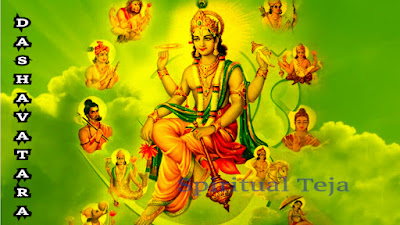 |
| Dashavatara |
The "Dashavatara" refers to the ten principal incarnations of Lord Vishnu in Hinduism. Vishnu, one of the principal deities in Hinduism, is believed to incarnate on Earth whenever there is a crisis and dharma (righteousness) is threatened. Each of these incarnations, known as avatars, serves a specific purpose and teaches profound spiritual and moral lessons.
Here are the ten incarnations of Lord Vishnu in the Dashavatara:
1. Matsya (The Fish):
In this avatar, Lord Vishnu took the form of a fish to save the sage Manu and the Saptarishi (seven great sages) from a great deluge (flood) by guiding them and a boat to safety. The Matsya avatar symbolizes protection and preservation.
2. Kurma (The Tortoise):
Lord Vishnu assumed the form of a tortoise to support Mount Mandara during the churning of the ocean (Samudra Manthan) to obtain the nectar of immortality (amrita). The Kurma avatar represents stability and patience.
3. Varaha (The Boar):
Vishnu incarnated as a wild boar to rescue the Earth (personified as the goddess Bhudevi) from the demon Hiranyaksha, who had submerged it in the cosmic ocean. The Varaha avatar signifies the protection of righteousness and the restoration of balance.
4. Narasimha (The Man-Lion):
In this unique form, Lord Vishnu emerged as a half-man, half-lion to defeat the demon king Hiranyakashipu, who could not be killed by man or beast. The Narasimha avatar embodies the triumph of good over evil.
5. Vamana (The Dwarf Brahmin):
Vishnu incarnated as a dwarf Brahmin to subdue the demon king Bali, who had gained control over the three worlds. Vamana symbolizes humility, sacrifice, and the victory of righteousness.
6. Parashurama (The Warrior with an Axe): Lord Vishnu took on the form of a fierce warrior Brahmin to rid the world of corrupt and oppressive Kshatriya (warrior) rulers. Parashurama represents the power to restore justice and uphold dharma.
7. Rama (The Prince of Ayodhya):
Vishnu's incarnation as Lord Rama is one of the most beloved and revered. Rama's life, as depicted in the epic Ramayana, illustrates the qualities of an ideal king, husband, and devotee. His avatar highlights the importance of righteousness, duty, and devotion.
8. Krishna (The Divine Cowherd):
Lord Krishna, the central figure in the Mahabharata and the Bhagavad Gita, embodies divine love, compassion, and wisdom. His teachings emphasize devotion and spiritual enlightenment.
9. Buddha (The Enlightened One):
Some interpretations of the Dashavatara include Lord Buddha as an incarnation of Lord Vishnu. Buddha's teachings focused on the alleviation of human suffering and the path to enlightenment.
10. Kalki (The Future Warrior):
Kalki is believed to be a future avatar of Lord Vishnu who will appear in the future to end the current age of darkness and corruption (Kali Yuga). He is envisioned as a warrior on a white horse, wielding a sword, and restoring righteousness.
The Dashavatara concept represents the cyclic nature of time and the belief in the periodic appearance of divine incarnations to restore balance and uphold dharma in the universe. These avatars collectively represent the multifaceted aspects of divinity and provide guidance for living a righteous and spiritually fulfilling life.








No comments: